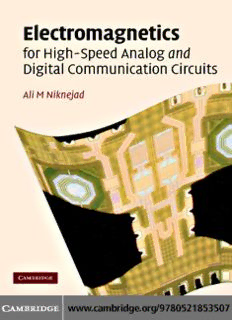Table Of ContentThis page intentionally left blank
Electromagnetics for High-Speed Analog and
Digital Communication Circuits
Moderncommunicationstechnologydemandssmaller,faster,andmoreefficientcircuits,the
designofwhichrequiresagoodunderstandingofcircuittheoryandelectromagnetics.This
bookreviewsthefundamentalsofelectromagnetismasappliedtopassiveandactivecircuit
elements,highlightingthevariouseffectsandpotentialproblemsindesigninganewcircuit.
The author begins with a review of the basics: the origin of resistance, capacitance, and
inductance,fromacircuitandfieldperspective;thenprogressestomoreadvancedtopics
such as passive device design and layout, resonant circuits, impedance matching, high-
speedswitchingcircuits,andparasiticcouplingandisolationtechniques.Usingexamples
and applications in RF and microwave systems, the author describes transmission lines,
transformers,anddistributedcircuits.State-of-the-artdevelopmentsinSi-basedbroadband
analog, RF, microwave, and mm-wave circuits are also covered. With up-to-date results,
techniques, practical examples, many illustrations, and worked examples, this book will
be valuable to advanced undergraduate and graduate students of electrical engineering
andpractitionersintheICdesignindustry.Furtherresourcesforthistitleareavailableat
www.cambridge.org/9780521853507.
ali m. niknejadobtainedhisPh.D.in2000fromtheUniversityofCalifornia,Berkeley,
whereheiscurrentlyanassociateprofessorintheEECSdepartment.Heisafacultydirector
attheBerkeleyWirelessResearchCenter(BWRC)andtheco-directoroftheBSIMResearch
Group.BeforehisappointmentatBerkeley,Niknejadworkedforseveralyearsinindustry
designingCMOSandSiGeICs.HehasalsoservedasanassociateeditoroftheIEEEJournal
of Solid-State Circuits, and was a co-recipient of the Jack Raper Award for Outstanding
TechnologyDirectionsPaperatISSCC2004.
Electromagnetics for
High-Speed Analog and Digital
Communication Circuits
ALI M. NIKNEJAD
CAMBRIDGE UNIVERSITY PRESS
Cambridge, New York, Melbourne, Madrid, Cape Town, Singapore, São Paulo
Cambridge University Press
The Edinburgh Building, Cambridge CB2 8RU, UK
Published in the United States of America by Cambridge University Press, New York
www.cambridge.org
Information on this title: www.cambridge.org/9780521853507
© Cambridge University Press 2007
This publication is in copyright. Subject to statutory exception and to the provision of
relevant collective licensing agreements, no reproduction of any part may take place
without the written permission of Cambridge University Press.
First published in print format 2007
ISBN-13 978-0-511-27009-3 eBook (NetLibrary)
ISBN-10 0-511-27009-7 eBook (NetLibrary)
ISBN-13 978-0-521-85350-7 hardback
ISBN-10 0-521-85350-8 hardback
Cambridge University Press has no responsibility for the persistence or accuracy of urls
for external or third-party internet websites referred to in this publication, and does not
guaranteethatanycontentonsuchwebsitesis,orwillremain,accurateorappropriate.
Contents
Preface pageix
Acknowledgments xi
1 Introduction 1
1.1 Motivation 1
1.2 SysteminPackage(SiP):chipandpackageco-design 13
1.3 Futurewirelesscommunicationsystems 13
1.4 Circuitsandelectromagneticsimulation 15
2 Capacitance 18
2.1 Electrostaticsreview 18
2.2 Capacitance 32
2.3 Non-linearcapacitance 41
2.4 References 52
3 Resistance 53
3.1 Ohm’sLaw 53
3.2 Conductioninsemiconductors 59
3.3 Diffusion 66
3.4 Thermalnoise 68
3.5 References 73
4 Ampe`re,Faraday,andMaxwell 74
4.1 Ampe`re:staticmagneticfields 74
4.2 Magneticmaterials 82
4.3 Faraday’sbigdiscovery 88
4.4 Maxwell’sdisplacementcurrent 91
4.5 References 95
5 Inductance 96
5.1 Introduction 96
5.2 Inductance 97
5.3 Magneticenergyandinductance 101
5.4 Discussionofinductance 106
v
vi Contents
5.5 Partialinductanceandreturncurrents 119
5.6 Impedanceandqualityfactor 120
5.7 Frequencyresponseofinductors 121
5.8 Qualityfactorofinductors 130
5.9 Inductorsandswitchingcircuits 133
5.10 Preview:howinductorsmutateintocapacitors 135
5.11 References 136
6 Passivedevicedesignandlayout 137
6.1 Ringinductor 137
6.2 Theclassiccoil 141
6.3 Spirals 143
6.4 Symmetricinductors 145
6.5 Multilayerinductors 147
6.6 Inductorequivalentcircuitmodels 149
6.7 Integratedcapacitors 150
6.8 Calculationbymeansofthevectorpotential 153
6.9 References 165
6.10 Appendix:Filamentalpartialmutualinductance 165
7 Resonanceandimpedancematching 168
7.1 Resonance 168
7.2 ThemanyfacesofQ 180
7.3 Impedancematching 186
7.4 Distributedmatchingnetworks 199
7.5 Filters 199
7.6 References 200
8 Small-signalhigh-speedamplifiers 201
8.1 Broadbandamplifiers 202
8.2 Classicaltwo-portamplifierdesign 220
8.3 Transistorfiguresofmerit 242
8.4 References 244
9 Transmissionlines 246
9.1 Distributedpropertiesofacable 246
9.2 Aninfiniteladdernetwork 248
9.3 Transmissionlinesasdistributedladdernetworks 249
9.4 Transmissionlinetermination 253
9.5 Losslesstransmissionlines 255
9.6 Lossytransmissionlines 260
9.7 Fieldtheoryoftransmissionlines 264
9.8 T-linestructures 265
9.9 Transmissionlinecircuits 272
Contents vii
9.10 TheSmithChart 282
9.11 Transmissionline-matchingnetworks 287
9.12 References 292
10 Transformers 293
10.1 Idealtransformers 293
10.2 Dotconvention 294
10.3 Coupledinductorsastransformers 295
10.4 Coupledinductorequivalentcircuits 296
10.5 Transformerdesignandlayout 299
10.6 Baluns 301
10.7 Hybridtransformer 302
10.8 Transformerparasitics 305
10.9 Transformerfiguresofmerit 305
10.10 Circuitswithtransformers 310
10.11 References 319
11 Distributedcircuits 320
11.1 DistributedRCcircuits 320
11.2 Transmissionlinetransformers 325
11.3 FETsathighfrequency 332
11.4 Distributedamplifier 335
11.5 References 342
12 High-speedswitchingcircuits 343
12.1 Transmissionlinesandhigh-speedswitchingcircuits 343
12.2 Transientsontransmissionlines 345
12.3 Stepfunctionexcitationofaninfiniteline 346
12.4 Terminatedtransmissionline 348
12.5 Reactiveterminations 357
12.6 Transmissionlinedispersion 360
12.7 References 363
13 Magneticandelectricalcouplingandisolation 364
13.1 Electricalcoupling 364
13.2 Magneticcoupling 367
13.3 Groundnoisecoupling 373
13.4 Substratecoupling 378
13.5 Packagecoupling 383
13.6 References 385
14 Electromagneticpropagationandradiation 386
14.1 Maxwell’sequationsinsource-freeregions 386
14.2 Penetrationofwavesintoconductors 390
viii Contents
14.3 Poyntingvector 395
14.4 EMpowercarriedbyaplanewave 397
14.5 ComplexPoyntingTheorem 399
14.6 Reflectionsfromaperfectconductor 402
14.7 Normalincidenceonadielectric 404
14.8 References 406
15 Microwavecircuits 407
15.1 Whataremicrowavecircuits? 407
15.2 Microwavenetworks 409
15.3 Lorentzreciprocitytheorem 409
15.4 Thenetworkformulation 412
15.5 Scatteringmatrix 414
15.6 Propertiesofthree-ports 421
15.7 Propertiesoffour-ports 429
15.8 Twoconductorcoupler 438
15.9 References 440
References 441
Index 445
Description:Modern communications technology demands smaller, faster and more efficient circuits. This book reviews the fundamentals of electromagnetism in passive and active circuit elements, highlighting various effects and potential problems in designing a new circuit. The author begins with a review of the

